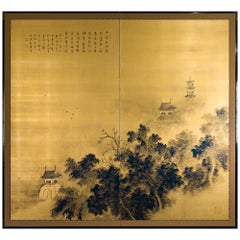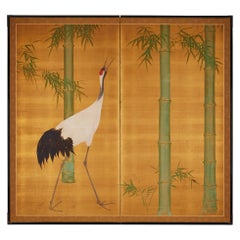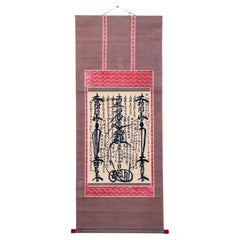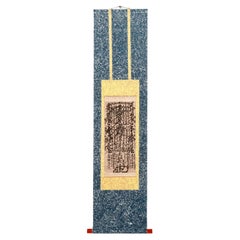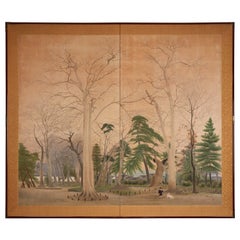Japanese Paintings and Screens
2
790
50
to
125
507
181
840
826
827
13
9
2
117
316
357
50
166
88
12
23
4
15
12
2
7
6
3
1
477
446
416
287
271
1,519
1,365
840
467
88
3
3
2
1
1
Place of Origin: Japanese
Japanese Contemporary Gold Green Purple Framed Porcelain Panel by Master Artist
Located in Takarazuka, JP
Extraordinary Japanese large contemporary framed porcelain panels artwork in three pieces intricately hand painted showcasing a wintry scene of a gracefully shaped aged snow covered ...
Category
21st Century and Contemporary Meiji Japanese Paintings and Screens
Materials
Gold
Japanese Two-Panel Screen Temples Through Misty Forest
Located in Hudson, NY
Japanese two-panel screen: Temples Through Misty Forest. Chinese School landscape ink painting on gilded silk by Yukimatsu Shunpo, signed and dated 1924. Yukimatsu Shunpo was born in...
Category
1920s Taisho Vintage Japanese Paintings and Screens
Materials
Wood, Silk
Japanese Two Panel Screen: Bamboo and Manchurian Crane
Located in Hudson, NY
Kano style painting in mineral pigments on silk with a silk brocade border.
Category
Early 20th Century Japanese Paintings and Screens
Materials
Brocade, Silk
Japanese Gohonzon Buddhist Calligraphy Mandala Scroll Meiji Period
Located in Atlanta, GA
A Japanese sumi ink calligraphy Buddhist mandala mounted as a paper hanging scroll known as Kakejiku or sometimes Moji mandala. Termed as gohonzon in Japanese, it is a venerated object within Nichiren Buddhism (Hokkeshu; lotus sect). The originally concept was developed by the 13th century Buddhist priest Nichiren to guide the energy of the devotional chanting to...
Category
1890s Meiji Antique Japanese Paintings and Screens
Materials
Paper
Early Japanese Gohonzon Buddhist Calligraphy Mandala Scroll Edo Period
Located in Atlanta, GA
A Japanese sumi ink calligraphy Buddhist mandala mounted as a paper hanging scroll known as Kakejiku or sometimes Moji mandala. Termed as gohonzon in Japanese, it is a venerated object within Nichiren Buddhism (Hokkeshu; lotus sect). The originally concept was developed by the 13th century Buddhist priest Nichiren to guide the energy of the devotional chanting to...
Category
1810s Edo Antique Japanese Paintings and Screens
Materials
Paper
Japanese Two Panel Screen: A Boy and His Shiba Dog on Temple Grounds
Located in Hudson, NY
Artist: Katsumi Aizu, who won many awards at Inten Exhibition. Ink and mineral pigments on mulberry paper with a silk brocade border.
Category
Early 20th Century Japanese Paintings and Screens
Materials
Brocade, Silk, Paper
Japan Small Folding Two-Panel Furosaki Tea Screen "Contemporary Simplicity"
Located in South Burlington, VT
Japan folding two-panel tea screen furosaki byobu depicting a simple cream colored back ground with a blue snow flake border, colors on paper 21.5” high and...
Category
Mid-20th Century Showa Japanese Paintings and Screens
Materials
Paper
Japan Beautiful Big Antique Hand Painted Kutani Garden Bowl, 1910
Located in South Burlington, VT
From our recent Japanese Acquisition Travels- a big and lovely big 13 inch diameter hand painted bowl from Japan.
Japan hard to find early hand painted ceramic lush "garden scene" serving bowl, circa 1910. Inside painting depicts elite individual with his attendants seated amidst a three some of cranes, plush patterns, foliage and seas. The exterior a dragon style...
Category
Early 20th Century Meiji Japanese Paintings and Screens
Materials
Ceramic
Japanese Two Panel Screen: Bamboo on Gold
Located in Hudson, NY
Bamboo grove on a knoll with stylized gold mist. Mineral pigments on gold leaf with silk brocade border.
Category
Early 19th Century Antique Japanese Paintings and Screens
Materials
Gold Leaf
Japanese Two Panel Screen, Ink Landscape on Paper with Gold Dust
Located in Hudson, NY
Sesshu-style painting in ink on mulberry paper with gold dust accents and a silk brocade border.
Category
19th Century Antique Japanese Paintings and Screens
Materials
Gold
Japanese Two Panel Screen: Rooster and Hens in Windswept Landscape
Located in Hudson, NY
Late Meiji Period (1868 - 1912) painting with a wonderful use of gold dust on mulberry paper with a silk brocade border. Signature reads: Ryutei.
Category
Late 19th Century Antique Japanese Paintings and Screens
Materials
Gold
Landscape and Waterfall Nihonga Scene Showa Period Scroll Japan Artist
Located in Amsterdam, Noord Holland
Some errors will occur in the dimensions. Please understand.
Status: The condition is good, but please understand stains, wrinkles, and stains.
Measures: Axis vertical 193 cm, hori...
Category
1930s Showa Vintage Japanese Paintings and Screens
Materials
Silk
Japanese Two Panel Screen, Lotus Leaves and Blossoms
Located in Hudson, NY
A lotus scene with flowers in bloom floating on the water's surface. As the lotus rise from below for an enlightening process that brings an abundance of purity and beauty. Mineral p...
Category
Early 20th Century Japanese Paintings and Screens
Materials
Wood, Lacquer, Paper
Japan Scroll Painting, Meiji Period
Located in Pasadena, CA
This is a wonderful example of a Meiji Period screen painting of Japanese Tanuki or racoon dogs in a landscape. The Tanuki is considered to be a mythical creature Japanese culture. T...
Category
Late 19th Century Meiji Antique Japanese Paintings and Screens
Materials
Fabric, Paint
Japanese Two Panel Screen: Mandarin Ducks in Winter
Located in Hudson, NY
Fine painting of a variety of waterfowl in rich mineral pigments on gold leaf with a silk brocade border.
Category
19th Century Antique Japanese Paintings and Screens
Materials
Gold Leaf
Japanese Two Panel Screen: Kanzan and Jittoku
Located in Hudson, NY
Prominent figures in Japanese folklore. The Chinese poet-sage Kanzan is depicted with his scroll, and the Daoist sage Jittoku with his broom. Painting bears two seals of Nakanuma Sho...
Category
Late 19th Century Antique Japanese Paintings and Screens
Materials
Gold
Antique Japanese Painting Framed on Jute 'Lovers Dance'
Located in Milano, IT
Antique and very rare Japanese painting made in the early 1900s by a fine Japanese manufacturer.
The painting has a rectangular brass frame with rounded corners. Internally we see a...
Category
Early 1900s Anglo-Japanese Antique Japanese Paintings and Screens
Materials
Brass
Japanese Four Panel Screen: Family of Chickens
Located in Hudson, NY
Meiji period painting (1868 - 1912) of rooster, hen, and chicks in mineral pigments and ink on mulberry paper with silk brocade border. Signed Soken.
Category
19th Century Antique Japanese Paintings and Screens
Materials
Brocade, Silk, Paper
Japanese Two Panel Screen: Hawk Perched in Pine Tree
Located in Hudson, NY
Hawks were a popular motif in artwork because Japanese falconry, or takagari, was a sport of aristocrats such as nobles and samurai. Hawks came to symbolize nobility and strength. Su...
Category
17th Century Antique Japanese Paintings and Screens
Materials
Brocade, Silk, Paper
Framed Japanese Portrait of a Buddhist Priest by Goro Kamenaga
Located in Atlanta, GA
A gouache on silk painting of a Buddhist priest by Japanese painter Goro Kamenaga (1890-1955). The highly realistic painting depicts a figure in seate...
Category
1910s Meiji Vintage Japanese Paintings and Screens
Materials
Silk
Japanese Silk Scroll of Daruma Hanabusa Itcho Edo Period
Located in Atlanta, GA
A Japanese hanging scroll attributed to Edo period painter Hanabusa Itcho (1652-1724). The artwork features a silk roundel nicely mounted in golden brocade background. The painting depicts a robed Daruma seated in meditation with his eyes widely open. The rendition of the famous monk, one of the most beloved subjects in Japanese art, was extremely minimalistic. With just a few effective ink strokes and patches of watercolor, it managed to successfully highlight the essence and spirit of Daruma. The roundel was possibly a center fragment of a larger painting by the artist and was remounted historically. Signed with one of his artist's names. It comes with a wood scroll box with ink inscription of title and artist formal name.
For a painting with the same signature, see number 1881,1210,0.1719 in the collection of the British Musuem. Also a horizontal scroll...
Category
18th Century Edo Antique Japanese Paintings and Screens
Materials
Silk, Paper
Japanese Two Panel Screen, Chrysanthemums
Located in Hudson, NY
Beautiful white chrysanthemums are emphasized by heavy gold on a soft floral landscape, while gold clouds create a striking and dream-like floral scene. Gold leaf and gofun with min...
Category
Early 18th Century Antique Japanese Paintings and Screens
Materials
Gold, Gold Leaf
Japanese Miniature Four-Panel Screen Blue and Green Landscape
Located in Rio Vista, CA
19th century mid-Edo period Japanese four-panel miniature screen. Depicting a beautifully painted Chinese blue and green landscape in the Nanga School...
Category
19th Century Edo Antique Japanese Paintings and Screens
Materials
Brass
Japanese Screen "the Song of Everlasting Sorrow"
Located in PARIS, FR
Six-panels screen depicting the exit from the city of a Chinese emperor on horseback and his concubine in a luxurious palanquin.
It may be a scene illustrating the poem The Song ...
Category
Late 17th Century Antique Japanese Paintings and Screens
Materials
Silk, Wood, Paper
Meiji Period Japanese Screen Pair, One Hundred Birds by Hasegawa Gyokujun
Located in Kyoto, JP
One hundred birds
Hasegawa Gyokujun (1863-1921)
Meiji period, circa 1900.
Ink, color and gofun on silk.
Dimensions of each screen:
H. 170 cm x W. 190 cm (67’’ x 75”)
Despite the title, well over 100 birds are represented in this pair of two-fold Japanese screens (the title functions figuratively to convey the idea of a large number). The monumental work is rendered with a comprehensive and highly complex composition which is exquisitely executed and meticulously colored. More a celebration of naturalism than the traditional “One Hundred Birds” paintings which originated in China. This was a subject matter known for its auspicious meaning as much as its actual depiction of nature. These paintings generally had a phoenix (occasionally peacocks) placed in the center, and the other birds paying homage to it.
In this quintessentially Japanese scene painted by Gyokujun, a couple of long-tailed birds modeled after paradise flycatchers are included; these are traditional auspicious motifs in Oriental bird and flower painting and denote themes such as celebration and enduring generations. In addition there is the playful inclusion of single exotic parrot. Even so, the vast majority of the birds and flowers are native to Japan. Reading the scene from right to left, from spring through to autumn, the overwhelming sense is one of movement and haste. It is almost as if the birds are in a race, with the fleetest leading the way forward. Although these native birds were commonly drawn amongst artists of the Shijo school, rarely were they painted with such drama and dynamism. It is not strictly a depiction of sketched birds whose manner was faithfully handed down through the traditions of the Shijo school. Rather we see Gyokujun seeking and achieving new expressions in the heart of the turbulent Meiji period.
Hasegawa Gyokujun (1863-1921) was born in Kyoto. He was the eldest son of Hasegawa Gyokuho, a Shijo school painter who studied under Matsumura Keibun. Gyokujun studied painting under his father and became a prominent member of the Kyoto painti
ng world from a young age. In 1891 he established the ‘Young Painters Social Club’ along with Takeuchi Seiho, Miyake Gogyo and Taniguchi Kokyo. Also in 1891 he was selected as a judge of the Great Private Paintings Exhibition along with Takeuchi Seiho, Yamamoto Shunkyo...
Category
Early 1900s Meiji Antique Japanese Paintings and Screens
Materials
Silk, Wood
17th Century Japanese Screen. Ink Plum Tree & Birds by Kano Naonobu.
Located in Kyoto, JP
Kano Naonobu (1607-1650)
Plum Tree and Birds
Six-fold Japanese Screen. Ink and slight color on paper.
In this evocative ink work spread over a six-panel folding screen, we see the consummation of the elegance and refinement of the Edo Kano school. This 17th century screen is a rare surviving example of a large-scale bird and flower painting by Kano Naonobu, the younger brother of Kano Tanyu...
Category
17th Century Edo Antique Japanese Paintings and Screens
Materials
Wood, Paper
Japanese Six Panel Screen: Plain Silver Leaf on Paper
Located in Hudson, NY
(no image) With beautiful oxblood color lacquer frame with 19th century bronze mounts.
Category
Early 20th Century Japanese Paintings and Screens
Materials
Bronze, Silver Leaf
Large Collotype Print by Ryunosuke Fukui 'from "Maiko" Series'
Located in Fukuoka, JP
A large print created by Ryunosuke Fukui, a highly acclaimed modernist artist from Japan who lived between 1923 and 1986. Fukui's art has been exhibited in many prestigious museums and galleries, and his works are included in the permanent collection of the Tokyo National Modern Art museum and other renowned institutions. This particular print is part of a limited edition series called "Maiko", which includes 200 sets featuring 10 collotype prints each. The print available is from the 100th edition, and it dates back to 1975. It measures 49.5 by 38.5 centimeters.
Ryonosuke Fukui...
Category
Mid-20th Century Showa Japanese Paintings and Screens
Materials
Paper
Japanese Two Panel Screen: Irises on Gold
Located in Hudson, NY
Japanese Two Panel Screen: Irises on Gold
Showa period (1926 - 1989) painting, beautifully mounted with silvered hardware. Seal reads: Eishun. Mineral pigments on gold with a silk ...
Category
20th Century Showa Japanese Paintings and Screens
Materials
Brass
Large Japanese 2-Panel Byôbu 屏風 'Room Divider' with Painting of Bamboo & a Poem
Located in Amsterdam, NL
Beautiful, large two-panel byôbu (room divider) with a serene painting of red-leaved bamboo and rocks on an oxidized silver leaf background. Silver leaf continuously undergoes the process of oxidation, which creates a beautiful aged patina.
On the left an inscription from a ‘Zekku’ poem by the Chinese poet Yang Zai (1271?1323), titled: Shan shang zhu (bamboo (painted) on a fan).
Translated as :
Why would people plant a lot of bamboos?
The shade of a single culm is also beautiful.
In the autumn night it rocks on the wind,
And the fresh sound echoes in my dream.
Dated: Shôwa, the year kôshin (1938). Signature unknown...
Category
Early 20th Century Japanese Paintings and Screens
Materials
Other, Silver Leaf
Antique Framed Japanese Shunga Woodblock Print of a Couple Making Love
Located in Yonkers, NY
An antique Japanese Shunga woodblock print in gilt frame depicting a man and a woman making love. Created in Japan, this woodblock print called...
Category
19th Century Antique Japanese Paintings and Screens
Materials
Glass, Wood, Paint
Antique hanging scroll of Japanese cat/Late Edo-Meiji period/Cat painting
Located in Sammu-shi, Chiba
This is a picture of a cat drawn by a person named "Toshizumi Nitta" from the end of the Edo period to the beginning of the Meiji period.
She is a very simple and cute cat.
He is a vassal of the Tokugawa Shogunate, born in Ota City, Gunma Prefecture (southern part of Gunma Prefecture).
He was related to the Tokugawa family and lived in a large mansion in the Ota clan in Gunma prefecture.
However, the Nitta family's territory was very small, and they were by no means a wealthy vassal.
He seems to have lived quite poorly.
So he painted cats and sold them to people.
The Nitta family continued to draw pictures of this cat for four generations.
"Nitta toshizumi" is equivalent to the fourth generation.
During the Edo period, sericulture was thriving in the Kanto region.
Cats were said to be the gods of silkworms, as they drive away mice, the natural enemies of silkworms.
It was the Nitta family who drew such a cat on paper, pasted it in the silkworm chamber, and sold it as a mouse repellent.
There were also other monks who painted pictures of cats, but the Nitta family in particular was related to the Tokugawa family, so people believed that paintings of cats had special powers. , a lot of paintings...
Category
Late 19th Century Edo Antique Japanese Paintings and Screens
Materials
Paper
Vintage Japanese Fine Art Painting Water Lillies Asian Antiques 中国古董
Located in London, GB
A fine Japanese Fine Art drawing of water lilies by Toru Suzuki
Acrylic Crayon mixed media,
Beautiful and elegant example
Ex Gallery Kabtoya Tok...
Category
20th Century Japanese Paintings and Screens
Materials
Canvas
Large Collotype Print by Ryunosuke Fukui 'from "Maiko" Series'
Located in Fukuoka, JP
A large print created by Ryunosuke Fukui, a highly acclaimed modernist artist from Japan who lived between 1923 and 1986. Fukui's art has been exhibited in many prestigious museums and galleries, and his works are included in the permanent collection of the Tokyo National Modern Art museum and other renowned institutions. This particular print is part of a limited edition series called "Maiko", which includes 200 sets featuring 10 collotype prints each. The print available is from the 100th edition, and it dates back to 1975. It measures 49.5 by 38.5 centimeters.
Ryonosuke Fukui...
Category
Mid-20th Century Showa Japanese Paintings and Screens
Materials
Paper
Antique Taisho Period Tanzaku Woodblock Print of Heron at Twilight by Seiko
By Seiko
Located in Philadelphia, PA
A fine antique Taisho period Japanese woodblock print.
Depicting a swooping heron above a riverbed with a thin sliver of a crescent moon in the background.
By Seikо̄. Seikо̄ is tho...
Category
Early 20th Century Taisho Japanese Paintings and Screens
Materials
Paper
Japanese Six Panel Screen: Egrets in Flight
Located in Hudson, NY
A siege of Egrets glide along the warm golden backdrop. Mineral pigments and gold on mulberry paper with lacquered wood trim.
Category
Early 20th Century Japanese Paintings and Screens
Materials
Gold
Japanese Two-Panel Screen: Cranes on Gold
Located in Hudson, NY
Early Kano School painting of pine trees overlooking two beautifully painted cranes and floral design in a natural setting by water’s edge. Mineral pig...
Category
Late 18th Century Antique Japanese Paintings and Screens
Materials
Gold, Gold Leaf
Japanese Four-Panel Folding Screen Byobu Signed Showa Period C.1950
Located in London, GB
A four-panel Japanese Byobu folding screen depicting a floral scene with birds.
Japan, C.1950 Showa Period
An attractive example, beautifully h...
Category
Mid-20th Century Showa Japanese Paintings and Screens
Materials
Silk, Paper
Japanese Two Panel Screen: Mandarin Ducks Among Dry Lotus
Located in Hudson, NY
Natural scene of Mandarin ducks gliding gracefully amongst the water.
Mineral pigments on silk with silk brocade border and natural wood trim. Seal reads: Kei.
Category
Early 20th Century Japanese Paintings and Screens
Materials
Silk, Wood
Japanese Edo Period Six Panel Screen of Chinese Scholars
Located in Rio Vista, CA
Fascinating 19th century Japanese late Edo period six pane funpon screen. Large scale depicting Chinese scholars and officials engaged in leis...
Category
19th Century Edo Antique Japanese Paintings and Screens
Materials
Wood, Paper, Silk
Japanese Showa Two Panel Screen Embroidered Silk Gilt Boxes
Located in Rio Vista, CA
Charming Japanese Showa period two-panel folding byobu screen featuring an embroidered silk picture of beautiful gift boxes. Stunning pattern of Hanaguruma (flower cart) laden with d...
Category
20th Century Mid-Century Modern Japanese Paintings and Screens
Materials
Silk, Wood, Paper
Japanese Four Panel Screen: Japanese Tree Sparrows on Stacks of Bailed Rice
Located in Hudson, NY
Sparrows ravish freshly harvested rice, drying on stakes, beyond wild chrysanthemum. Mineral pigments on silk. Signed in the lower left corner, signature reads: Soetsu. With a simple...
Category
Early 20th Century Japanese Paintings and Screens
Materials
Wood, Lacquer, Silk
19th Century Japanese Screen for Tea-Ceremony, Ink Bamboo and Plum on Gold Leaf
Located in Kyoto, JP
Three Friends of Winter
Nakajima Raisho (1796-1871)
Late Edo period, circa 1850
Ink and gold leaf on paper.
This is a double-sided Japanese Furosaki or tea-ceremony screen from the mid 19th century; bamboo and plum on the front, young pines the back. It by Nakajima Raisho, a master painter of the Maruyama school in the late Edo and early Meiji periods. In this work Raisho combines exquisite ink brushwork with large open spaces of brilliant gold-leaf to inspire the viewers imagination. Rather than naturalism, he is searching for the phycological impression of the motifs, resulting in abstraction and stylization. His simplification of the motifs the result of looking to capture the inner nature of the objects. This art motif is known as Sho Chiku Bai, or the Three Friends of Winter. Evergreen pine connotes steadfastness, bamboo suggests both strength and flexibility, while plum blossoms unfurling on snow-laden branches imply hardiness. Combined, this trio is emblematic of Japanese new year. Chinese literati were the first to group the three plants together due to their noble characteristics. Like these resilient plants flowering so beautifully in winter, it was expected of the scholar-gentleman to cultivate a strong character with which he would be able to show the same degree of perseverance and steadfastness even during times of adverse conditions.
The screen would have been placed near the hearth of a room used for the Japanese tea ceremony, shielding the fire from draughts and also forming a stimulating and decorative backdrop behind the tea utensils. It would have been used in the Hatsugama, or first tea-ceremony of the new year.
Nakajima Raisho (1796-1871) originally studied under Watanabe Nangaku before entering the school of Maruyama Ozui. He was the highest ranking Maruyama school painter at the end of the Edo period and was known as one of the ‘Four Heian Families’ along with Kishi...
Category
Mid-19th Century Edo Antique Japanese Paintings and Screens
Materials
Gold Leaf
Japanese Modernist Painting of a Seaside Village by Torao Ataka Dated 1930
By Japanese Studio
Located in San Francisco, CA
A Modern oil painting of a harbor town with the water and mountains views in the distance.
It is signed on the bottom left hand corner Ataka and dated '30 (1930).
The brushwork is ...
Category
1930s Modern Vintage Japanese Paintings and Screens
Materials
Canvas, Paint
Early 19th Century Japanese Screen. Cherry Blossom & Pheasants by Mori Tetsuzan
Located in Kyoto, JP
Mori Tetsuzan (1775-1841)
Pheasants and Cherry Blossoms
Two-fold Japanese screen. Ink, color, gofun, gold and silver on paper.
A two-fold Japanese bir...
Category
Early 19th Century Edo Antique Japanese Paintings and Screens
Materials
Gold Leaf
Japanese Two Panel Screen: Flowering Vines and Wisteria
Located in Hudson, NY
Wisteria represents sentiments of love and longevity as vibrant floral colors dance dramatically amongst the two panels. Mineral pigments on Mulberry paper with a natural wood trim....
Category
Early 20th Century Japanese Paintings and Screens
Materials
Wood, Paper
Japanese Silver Screen Pair, Meiji Period, Herons & Plovers, Shijo School
Located in Kyoto, JP
Heron & Plovers
Ink and silver leaf on paper
Maekawa Bunrei (1837-1917)
A pair of low six-panel Japanese screens by Maekawa Bunrei, a later master of the Kyoto based Shijo school of painting. On the right screen a solitary white heron stands motionless in a stream. On the left screen plovers play along a shoreline. The elegant forms are executed employing fluid, minimalistic ink brushstrokes. The soft brushstrokes and the sharp light of the silver leaf lend the scenes a sense of translucence. The sophisticated composition superbly exploits the long, horizontal pictorial surface of the pair of folding screens...
Category
Early 1900s Meiji Antique Japanese Paintings and Screens
Materials
Silver Leaf
Japanese Old Crane Painting / Picture Frame / 1900s-1930s / Picture of Two Crane
Located in Sammu-shi, Chiba
It is a framed picture of two cranes used in the space between the columns in the Meiji era.
The frame is made of chestnut and the color is like lacquer....
Category
Early 19th Century Japonisme Antique Japanese Paintings and Screens
Materials
Paper
Japanese Four Panel Screen, Golden Sun Through Turbulent Surf
Located in Hudson, NY
Golden sun viewed through red maple above turbulent waves. Mineral pigments on gold and silver ground with silk brocade border.
Category
Mid-20th Century Japanese Paintings and Screens
Materials
Gold Leaf, Silver Leaf
17th Century Japanese Screen Pair. Tiger & Dragon by Kaiho Yusetsu
Located in Kyoto, JP
Kaiho Yusetsu (1598-1677)
Tiger and Dragon
Early Edo Period, Circa 1650
A Pair of Six-fold Japanese Screens. Ink and slight color on paper.
Dimensions:
Each screen: H. 171 cm x W. 380 cm (67.5’’ x 149.5’’)
In this pair of early Edo period Japanese screens a group of tigers prowl in a bamboo grove whipped with fierce wind, while a dragon claws through clouds and mist. The dragon embodies elemental qualities - looming out of the mist, the coils of its body disappearing in the clouds. The dragon is calling for rain, symbolizing spring which is considered the fountain of life. On the other side, the tigers calls for the wind, symbolizing autumn which is considered the end of life. Tigers were familiar motifs within Japanese art from ancient times though the animals were imaginary to the people in the 17th century. While dragons and tigers are usually associated as sacred and ferocious, in this painting, both animals have rather amusing expressions. The tigers appear to glare at the dragon with cat-like eyes, and the look on the swirling dragon’s face appears almost affectionate - lending a playful flair to an otherwise magnificent theme.
The tiger and dragon are cosmological symbols of the balancing forces in the world. Screens such as this were originally meant to express the fluctuating nature of the world. For Japanese in the early Edo period, they likely suggested the powers of the cosmos. In Japan the tiger and dragon motif was originally absorbed into the circles of Zen monasteries before spreading into the secular world. The theme especially appealed to the military classes with the Kano school, the official painters to the Shogun and the samurai, being the leading contributors. The painter of this pair of screens, Kaiho Yusetsu (1598-1677), was closely patronized by the third Shogun Tokugawa Iemitsu. In his later years he worked with Kano school artists...
Category
Mid-17th Century Edo Antique Japanese Paintings and Screens
Materials
Silk, Wood, Paper
Japanese Two Panel Screen: Horses in Stable
Located in Hudson, NY
A pair of captivating black and white horses, believed to define hard work and power in Japanese mythology, are beautifully rendered in this painting of mineral pigments on mulberry ...
Category
Early 19th Century Antique Japanese Paintings and Screens
Materials
Bronze, Gold Leaf
Japanese Six Panel Screen: Red Maple and Flowers on Gold Silk
Located in Hudson, NY
Rimpa Floral Scene with Chrysanthemum, Morning Glories and Blue Bell Flowers. Pigment on gilded silk, signature and seal read: Hattori Shunyo. Bold colors and strong design elements combined with the trademark tarashikomi (diluted elements created when water is applied to the surface before or after pigments causing them to diffuse) exhibit the artists deep devotion to this important Japanese painting tradition. Notes about artist: Hattori Shunyo (b. 1883) was an artist from Kyoto who graduated the (now) Kyoto Municipal University of Art and fell under the circle of Yamamoto Shunkyo...
Category
Early 20th Century Japanese Paintings and Screens
Materials
Brocade, Silk
19th Century Japanese Shibayama Lacquered Inlay Charger, Meiji Period
Located in London, GB
19th Century Shibayama Lacquered Inlay Charger, Meiji Period, Japan
A decorative 19th Century Japanese charger beautifully depicting herons and pi...
Category
Late 19th Century Meiji Antique Japanese Paintings and Screens
Materials
Bone, Mother-of-Pearl, Lacquer
Japanese Meiji Chikanobu Toyohara Framed Woodblock Print with Archery Tournament
By Toyohara Chikanobu
Located in Yonkers, NY
A Japanese signed woodblock print by Chikanobu Toyohara (Chikanobu Yoshu), 1838-1912, titled "Start of an Archery Tournament", a tript...
Category
Late 19th Century Meiji Antique Japanese Paintings and Screens
Materials
Wood, Paper, Glass
19th Century Japanese Shunga Hand-Scroll, Katsukawa School
Located in Kyoto, JP
Shunga
Unknown artist
Meiji era, circa 1880
Hand-scroll mounted with 12 paintings
Ink, pigment and gofun on silk
Dimensions:
Each image measures H. 23.2 cm x W. 34.4 cm (9.15” x 13.5”)
The hand-scroll measures H. 28 cm x W. 540 cm (11” x 212”)
A set of 12 late 19th century Japanese Shunga paintings mounted as a hand-scroll. Two of the leaves bear the signature and seal ‘Setsuzan’, although we are unable to confirm the identity of the artist using this art name. 6 of the 12 images are taken almost directly from Katsukawa Shuncho’s late 18th century woodblock series, ‘Erotic Pictures...
Category
Late 19th Century Meiji Antique Japanese Paintings and Screens
Materials
Silk
Japanese Two-Panel Screen: Dramatic Splash by Suzuki Goro
Located in Hudson, NY
Sumi ink on Mulberry paper, with black lacquer trim and gilded bronze hardware. Signature reads: Suzuki Goro.
Category
Mid-20th Century Japanese Paintings and Screens
Materials
Bronze
Japanese Edo Period Painting Scroll Fisherman in Landscape Japan Artist Signed
Located in Amsterdam, Noord Holland
Japanse school Vissers in landschap
Rolschildering / scroll op zijde, houten rollers. B- 35 x 14.7 / 106 x 23.5 cm
35 x 14.7 / 106 x 23.5 cm
Category
Mid-19th Century Meiji Antique Japanese Paintings and Screens
Materials
Silk
Japanese Six Panel Screen: Clouds of Golden Mist
Located in Hudson, NY
Mineral pigments and gold on mulberry paper. Signature reads: Bunrei-Ga.
Category
Early 20th Century Japanese Paintings and Screens
Materials
Gold
Recently Viewed
View AllMore Ways To Browse
Antique Japanese Painting On Silk
Antique Japanese Paintings On Silk
Japanese Panel Folding
Japanese Edo Screens
Chinese Screen Two
Japanese Pictures
Edo Panel
Hand Painted Antique Screen
Vintage Asian Painting
Japanese Meiji Screen
Chinese Panel Lacquered Screen
Antique Door Screen
Antique Screen Doors
Chinese 4 Panel
Carved Window Panels
4 Panel Chinese
Black Lacquer Asian Painting
Asian Lattice

